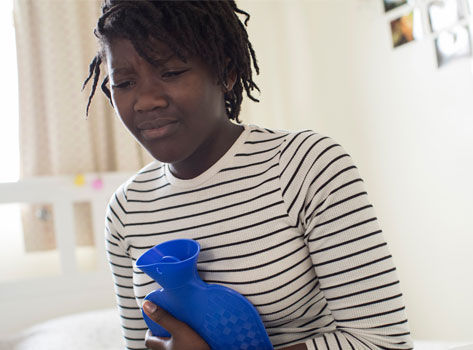
Endometriosis and polycystic ovarian syndrome (PCOS) are common disorders affecting menstruating people during their reproductive years. Both cause menstrual problems and both can lead to infertility.
Most teenagers aren’t looking to get pregnant, so why should adolescents learn about these conditions? According to Fatima Naqvi, MD, an obstetrician-gynecologist with Atlantic Health System, education needs to start as soon as menstruation begins so young patients are aware of what is and isn’t normal – and know when to seek treatment.
“These conditions often go unrecognized in the adolescent population, in part because some of the signs overlap with signs of puberty,” says Dr. Naqvi. “They can affect girls physically, socially and psychologically. By educating young patients when they first begin to menstruate, we can treat the conditions earlier and reduce their suffering – and hopefully increase their chances for optimal reproductive health in the future.”
So what should you know about adolescent endometriosis and PCOS? Dr. Naqvi shares the signs and symptoms to look for, possible risk factors and causes, treatment options and when to see an obstetrician-gynecologist (OBGYN).
Symptoms of Endometriosis and PCOS
Endometriosis occurs when endometrial (uterine lining) tissue grows outside your uterus; it’s associated with a cascade of local hormonal changes and the onset of local inflammation. PCOS is a common multifactorial, complex endocrine disorder. Both cause menstrual and fertility problems, but other symptoms vary – especially in adolescents.
With endometriosis, you often have a lot of pain in the pelvis, but not just during your cycle. Pain weeks before your period, pain when you urinate or have a bowel movement and even pain down the front your thighs is typical. “If you’re always in pain and you’re missing school or sitting out of activities, you need to see a doctor,” says Dr. Naqvi.
With PCOS, you may have pelvic pain, but more commonly your cycle will be irregular/infrequent and your flow will be heavy (think: flooding) or nonexistent. You will probably also experience oily skin and severe acne, excess body and facial hair, (head) hair thinning or loss and dark skin patches (called acanthosis nigricans).
“Irregular periods during the first three years of menstruation is not uncommon, and all teens have acne,” says Dr. Naqvi. “But going three months without a period or needing to use two pads or tampons at a time needs to be addressed.”
Causes and Risk Factors
More research needs to be done, but Dr. Naqvi believes chronic inflammation, hormonal imbalances and certain metabolic conditions like insulin resistance may contribute to you or your teen developing either of these conditions.
Family history, early menarche (first menstrual cycle before age 9), weight, diet and lifestyle choices, your environment and any sexual or physical trauma may also raise your risk.
Diagnosis and Treatment
While pelvic exams and imaging like ultrasounds are typical for adults and can help a doctor confirm diagnosis, with teens it’s different. “Their HPO (hypothalamic-pituitary-ovarian) axis hasn’t fully matured yet, so these tests aren’t always useful in younger patients,” explains Dr. Naqvi.
A better solution, according to Dr. Naqvi: “Lots of talking, listening and learning. By taking a full, thorough history – learning about their family, where they live and go to school, their diet and lifestyle and, of course, their cycle, flow and symptoms – we can make an educated diagnosis and begin treatment.”
As for treatment options, everyone is different, but Dr. Naqvi always recommends making healthy lifestyle changes, like a well-balanced diet and consistent exercise, to lower overall inflammation. Over-the-counter pain medicine can also help and hormonal medication, like birth control pills, may be necessary. With PCOS, you may also be prescribed Metformin to address insulin resistance (a driving force of PCOS) and regulate your cycle.
The bottom line is this: The earlier you address these conditions, the better chance you have for protecting your reproductive health in the future.
“If you are missing out on doing the things you love or are missing school, you need to speak with your doctor. Start with your pediatrician or find an obstetrician-gynecologist who can help,” urges Dr. Naqvi. “It’s all about your future reproductive health. If left untreated, these conditions will progress and can lead to infertility. Modifying your behavior now and beginning treatment if necessary gives you the best chance possible down the road.”
Be Proactive About Your Health
To stay safe and healthy, it's good to have a primary care provider who knows and understands your health history and wellness goals.